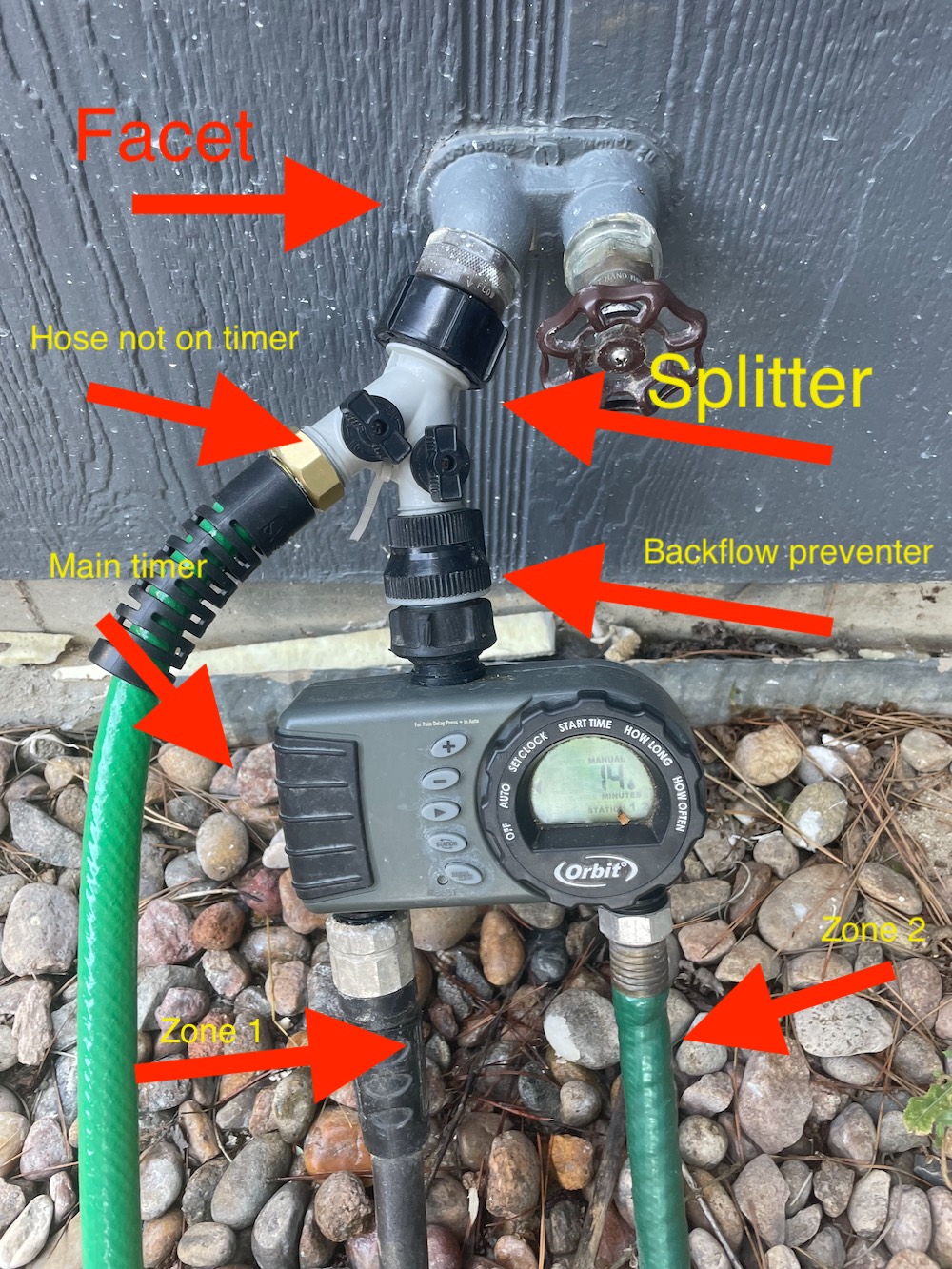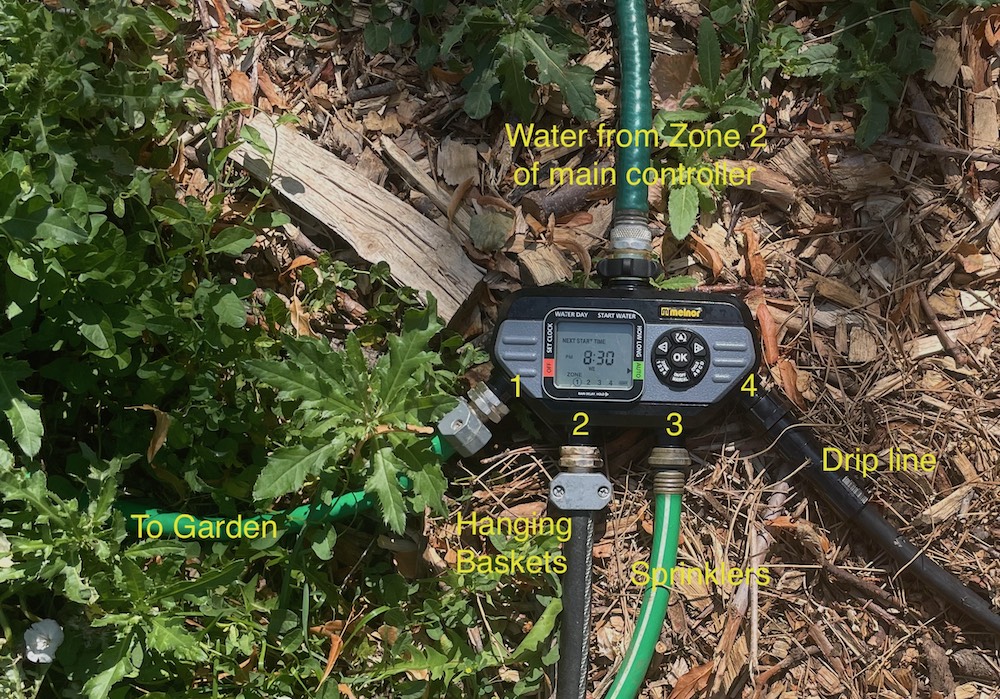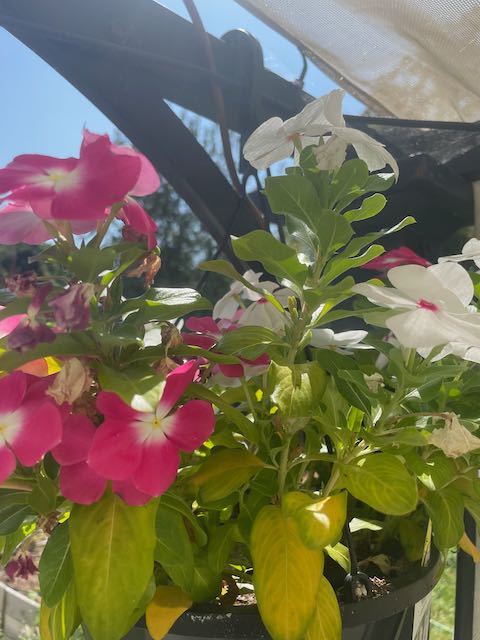Published: 08/23/2023
Back in April of 2022 we moved into a new house, giant house, mcmansion really (3400 sq ft across 2 levels). The lot is really massive, probably atleast 10-15,000 sq ft. Both the front and backyards lacked an automatic irrigation system not to mention the landscaping consisted of mostly weeds. Being cheap and very lazy, I set out to do my best to automate systems to care for my massive yard without the hassle of hiring a contractor and having them build a crappy system.
In recent years, I’ve found I generally hate residential contractors. If you have any major work done, expect to supervise them the way you’d supervise a 3 year old child. Bid after lame bid, I kept getting price tags of between $10,000 and $15,000 to do some simple things to my yard. Put in some mulch, plant some bushes and run some poly tubing. The margins are great for these builders. I being of the mind that almost anyone can figure it out so why shouldn’t I be able to do it, have grown in my abilities in tackling projects of various sizes.
Last summer was a successful experiment, could I keep my lawn green and thriving with a hose and a few simple timers? Yes I could. The front was ONLY 20’ by 50’, a whopping 1000 square feet, so it was hardly a challenge. My backyard is massive, atleast 100’ feet by 70’ feet in many places. The grass covers a minimum of 2500 square feet. Why am I putting water on it while I live in Colorado like a silly American? Because I’m an American, and I want the yard to be pretty.
I didn’t want to bury or run tubing, for a variety reasons not including having to call 811, it’s a lot of work among many other reasons. The biggest of which in my old house, inspite of yearly blow outs my automatic system ALWAYS had a major malfuction typically running $500 to $1000 to bring the system online, then a few hundred a month to figure out if I was watering enough or not.
The system

To prevent pouring $1000 a year on startup costs, I built my own system using hoses and timers. The way it works is like this:
- My facet on the west side of the house has a timer with 2 zones. Zone 1 runs sprinklers 1 and 2, approx 10’ and 20’ feet away. These run daily at 7:30 am for 15 minutes. This zone covers about 50% of my grass.
- Zone 2 runs in a 100’ foot hose to the east side of my yard, it feeds into a 4 port timer that feeds into 4 seperate sub systems.
The east side system

The east side system has 4 major zones:
- Garden beds using 1/4 inch soaker tubing for growing flowers, veggies and other things.
- The hanging baskets off of our pergola.
- The remaining 50% yard sprinkler.
- The newly mulched yard with our perennial flower garden plant on drip lines.
How do I get timing right with a zone inside another zone using 2 timers?
Here’s the timing table for the main timer from the facet:
| Zone | Duration | Scheduled Time | Role Description | Frequency |
|---|---|---|---|---|
| 1 | 30 minutes | 7:30 am | The west side of the yard’s 2 sprinklers for the watering of the grass | MWFS |
| 2 | 90 minutes | 5:15 am | The primary timer zone for the east zone, so we can water the other sub zones | Daily |
| 2 | 30 minutes | 8:30 pm | The east side has a drip timer for just the raised garden beds to ensure enough water | Daily |
Here’s the timing table for the east side:
| Zone | Duration | Scheduled Time | Role Description | Frequency |
|---|---|---|---|---|
| 1 | 15 minutes | 5:15 am | Raised beds | Daily |
| 1 | 30 minutes | 8:30 pm | Raised beds | Daily |
| 2 | 15 minutes | 5:30 am | Hanging baskets | Every other day |
| 3 | 40 minutes | 6:00 am | Grass | MWFS |
| 4 | 15 minutes | 6:30 am | Perennial garden | Daily |
The nice thing about this system is that if I need to skip days, all I need to do is set the main Zone 1 to water on a different schedule and it will affect everything downstream. Also if I wanted to add a general purpose fertlizer I could at the base of the system.
Parts List
The system is pretty straight forward, but below is a break down of the parts you would need to build something similar.
| Qty | Price | Item | Reason |
|---|---|---|---|
| 1 | $34 | 2 Zone Timer | This is for the main facet |
| 1 | $64 | 4 zone timer | I would buy two of these instead of the 2 zone and the 4 zone, that way you have more flexibility on both sides of the yard |
| 1 | $40 | 100’ hose | I would buy one of these at a local store, very expensive online |
| 3 | $20 | 25’ hose | I would buy a few of these and some male/female connectors so you can size them to your yard |
| 1 | $5 | Hose y splitter | For allowing you to bypass for regular hose usage |
| 1 | $8 | Backflow preventer | To prevent back up from the system to flow into your main water line |
| 1 | $15 | 100’ 1/4 Poly Tubing | For drip lines at the plant level |
| 1 | $30 | 100’ 1/2 poly tubing | For bringing water to an area for using with a drip line |
| 1 | $10 | 100 count drip sprayer | Great for hanging pots, and general use in watering the plants, not for lawns |
| 1 | $12 | Drip 1/4 soaker hose | Really helpful for garden beds |
| 3 | $16 | Large Sprinkler spinning | This thing is great, I have a hodge podge of sprinklers and I would standardize on 3 of these |
All in probably close to $350 worth of parts and moving pieces. It’s a bit complicated to get setup, but look at these amazing flowers below. It’s much smaller foot print of cost then an inground system. My front system was about $100, 2 sprinklers, 1 timer, a 25’ hose and poly drip line tubing. That has lasted for 2 seasons so far.

To winterize, just take the hose off and turn off the water. I cover the spouts with a winderized cover and you don’t need to blow the system out. You can disconnect the timers and store them if you’d like.